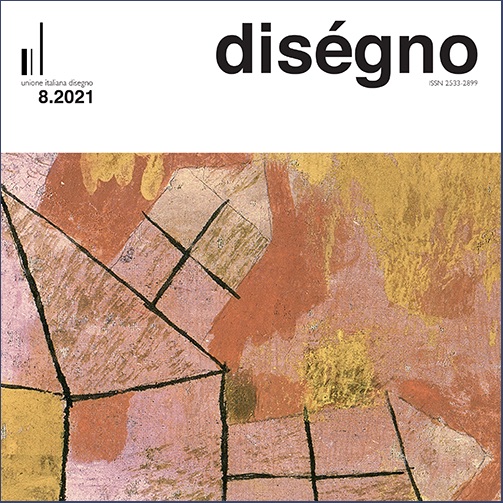Così lontano, quasi vicino
DOI:
https://doi.org/10.26375/disegno.8.2021.2Abstract
Introduzione
Ho accolto inizialmente con esitazione l’invito rivoltomi dall’amica e collega Francesca Fatta a riflettere sul tema Disegno: distanze, linguaggi, tecnologie in apertura della giornata di studi dell’Unione Italiana per il Disegno (UID) tenutasi online il 18 settembre 2020. I tre (quattro per la verità) termini evocati nel titolo del Seminario corrispondono ad altrettante categorie esistenziali ed esperienziali che, mai come in questi mesi di pandemia, hanno assunto significati ambigui e contraddittori, prima inimmaginabili. Il distanziamento fisico (ma non sociale) ci ha costretti a riflettere su come sia importante la prossimità per il genere umano e come questa ormai possa/debba esprimersi non solo attraverso il contatto in presenza, ma anche mediata da altre strutture comunicative, tutte incentrate sul visivo, ma incapaci di sollecitare in noi una soddisfacente risposta complessiva dei neuroni specchio e di agire in ambito sinestetico sui nostri sensi tutti... [continua a leggere]
Riferimenti bibliografici
Badiou, A. (2013). La Repubblica di Platone. Firenze: Ponte alle Grazie.
Ben She.Yi Ming (a cura di). (1997). Specification on the Stroke Order of Modern Chinese character. Shanghai (China): Yu Wen Press.
Borody, W. A. (1980). Heidegger on Plato’s cave alethology. Tesi di M.o.A. (Philosophy), McMaster University (Canada), December 1980.
Buisman, J. F. (1935). De ethische denkbeelden van Hendrik Laurensz Spiegel. Wageningen: H. Veenman & Zonen.
Collobert, C., Destrée, P., Gonzalez, F. J. (2012). Plato and Myth: Studies on the Use and Status of Platonic Myths. Leiden: Brill.
de Jong, A. C. (1930). H. L. Spiegels Hertspiegel, uitgegeven en taalkundig toegelicht door A. C. de Jong. Amsterdam: H. J. Paris.
De Rosa, A. (2021). Cecità del vedere. Per una storia alternativa delle immagini. In corso di stampa.
Eraclito. (1980). Frammenti e testimonianze. a cura di Carlo Diana, C., Serra, G. (a cura di). Milano: Arnoldo Mondadori Editore/Fondazione Lorenzo Valla.
Flint, H. L. (1921). The Heart: Old and New Views. London: Lewis.
Friedländer, P. (2014). Alétheia. Un confronto dell’autore con sé stesso e con Martin Heidegger. In P. Friedländer, Platone. Milano: Bompiani.
Giammarioli, M. (2007-2008). Il mito della caverna platonica nell’arte del Novecento. Tesi di Dottorato di ricerca. Sapienza Università di Roma, AA. 2007-2008, relatore prof.ssa A. Sbrilli; correlatore C. Marrone.
Harvey, W. (1628). Exercitatio anatomica de motu cordis et sanguinis in animalibus. Francofurti: Sumptibus Gvilielmi Fitzeri.
Knipping, J. B. (1939-1940). De Iconografie van de ContraReformatie in de Nederlandent. Hilversum: Brand.
Heidegger, M. (1987). Segnavia. Milano: Adelphi.
Heidegger, M. (1997). L’essenza della verità. F. Volpi, H. Mörchen. (a cura di). Milano: Adelphi.
Herman, A. (2013). The Cave and the Light. Plato Versus Aristotle, and the Struggle for the Soul of Western Civilization. New York: The Random House.
Hirschmann, O. (1915). Beitrag zu einem Kommentar von Karel van Manders, “Grondt der edel vry schilder-const”. In Oud Holland, vol. 33, pp. 81-86.
Knudsen, S. (2018). Japanese Calligraphy: Shodo. Copenhagen (Denmark): BoD.
McGee, J. L. (1991). Cornelis Corneliszoon Van Haarlem (1562-1638): Patrons, Friends, and Dutch Humanists. Leiden: Brill Academic Publishers.
Mecacci, A. (2006). La mimesis del possibile: approssimazioni a Hölderlin. Bologna: Edizioni Pendragon.
Murase, M., Barnet, S., Burto, W. (2002). The Written Image: Japanese Calligraphy and Painting from the Sylvan Barnet and William Burto Collection. New York (USA): Metropolitan Museum of Art.
Orenstein, N. M. (1995). Hendrick Hondius and the Business of Prints in Seventeenth-Century Holland, Rotterdam: Sound and Vision Interactive.
Platone. (2003). Opere Complete. Volume 2: Cratilo, Teeteto, Sofista, Politico. Roma-Bari: Laterza.
Platone. (2007). La Repubblica. Testo greco a fronte. M. Vegetti. (a cura di). Milano: BUR Rizzoli.
Sato, S. (2014). Shodo. The Quiet Art of Japanese Zen Calligraphy. Clarendon (USA): Tuttle Publishing.
Thesleff, H. (1982). Studies in Platonic Chronology. In Commentationes humanarum litterarum, 70. Helsinki: Societas Scientiarum Fennica.
Travers, M. (2019). The Writing of Aletheia. Martin Heidegger: In Language.
Oxford-Bern-Berlin-Bruxelles-New York-Wien: Peter Lang International Academic Publisher.
Vegetti, M. (1999). Guida alla lettura della Repubblica di Platone. Bari: Laterza.
Veldman, I. M. (1990). De Wereld tussen Goed en Kwaad late preten van Coornhert. L’Aja: SDU.
Verwey, A. (1919). Hendrick Laurensz. Spieghel. Groningen: JB Wolters.
Vinken, P. J. (1960). H. L. Spiegel’s Antrum Platonicum: A Contribution to the Iconology of the Heart. In Oud Holland, vol. 75, pp. 125-142.
Vinken, P. J. (1999). The shape of the heart. New York, Oxford: Elsevier.
Weddigen, T. (2003). Italienreise als Tugendweg Hendrick Goltzius’ Tabula Cebetis. In Nederlands Kunsthistorisch Jaarboek (NKJ) / Netherlands Yearbook for History of Art, vol. 54. Leiden: Brill, pp. 90-139.
##submission.downloads##
Pubblicato
Come citare
Fascicolo
Sezione
Licenza
Copyright (c) 2021 diségno

TQuesto lavoro è fornito con la licenza Creative Commons Attribuzione 4.0 Internazionale.






